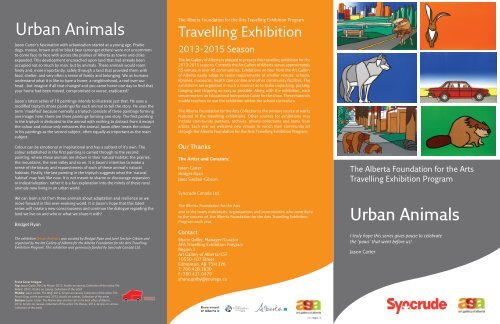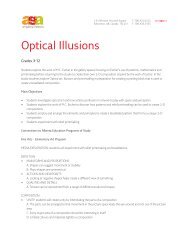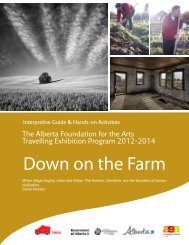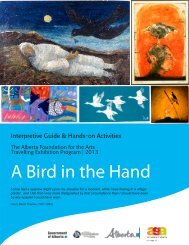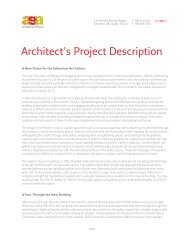Urban Animals Urban Animals - Art Gallery of Alberta
Urban Animals Urban Animals - Art Gallery of Alberta
Urban Animals Urban Animals - Art Gallery of Alberta
Create successful ePaper yourself
Turn your PDF publications into a flip-book with our unique Google optimized e-Paper software.
s<br />
<strong>Urban</strong> <strong>Animals</strong><br />
Jason Carter’s fascination with urbanization started at a young age. Prairie<br />
dogs, moose, brown and/or black bear (amongst others) were not uncommon<br />
to come face to face with across the prairies <strong>of</strong> <strong>Alberta</strong> as towns and cities<br />
expanded. This development encroached upon land that had already been<br />
occupied not so much by man, but by animals. These animals would roam<br />
freely and, more importantly, safely through a land that provided them with<br />
food, shelter, and very <strong>of</strong>ten a sense <strong>of</strong> family and belonging. We as humans<br />
understand what it is like to have a home, a neighborhood, a ro<strong>of</strong> over our<br />
head…but imagine if all that changed and you came home one day to find that<br />
your home had been moved, compromised or worse, eradicated<br />
Jason’s latest series <strong>of</strong> 18 paintings intends to illustrate just that. He uses a<br />
modified triptych (three paintings) for each animal to tell the story. He uses the<br />
term ‘modified’ because normally a triptych consists <strong>of</strong> three paintings forming<br />
one image; here, there are three paintings forming one story. The first painting<br />
in the triptych is dedicated to the animal with nothing to distract from it except<br />
the colour and colour only enhances the animal. Jason <strong>of</strong>ten treats the colour<br />
in his paintings as the second subject, <strong>of</strong>ten equally as important as the main<br />
subject.<br />
Colour can be emotional or inspirational and has a subtext <strong>of</strong> it’s own. The<br />
colour established in the first painting is carried through to the second<br />
painting, where these animals are shown in their natural habitat: the prairies,<br />
the mountains, the river valley and so on. It is Jason’s intention to evoke a<br />
sense <strong>of</strong> the beauty and expansiveness <strong>of</strong> each <strong>of</strong> these animal’s natural<br />
habitats. Finally, the last painting in the triptych suggests what the ‘natural<br />
habitat’ may look like now. It is not meant to shame or discourage expansion<br />
or industrialization: rather it is a fun exploration into the minds <strong>of</strong> these rural<br />
animals now living in an urban world.<br />
We can learn a lot from these animals about adaptation and resilience as we<br />
move forward in this ever-evolving world. It is Jason’s hope that this latest<br />
series will create a new consciousness and continue the dialogue regarding the<br />
land we live on and who or what we share it with!<br />
Bridget Ryan<br />
The exhibition <strong>Urban</strong> <strong>Animals</strong> was curated by Bridget Ryan and Jaret Sinclair-Gibson and<br />
organized by the <strong>Art</strong> <strong>Gallery</strong> <strong>of</strong> <strong>Alberta</strong> for the <strong>Alberta</strong> Foundation for the <strong>Art</strong>s Travelling<br />
Exhibition Program. This exhibition was generously funded by Syncrude Canada Ltd.<br />
Front Cover Images:<br />
Top: Jason Carter,The City Moose, 2012, Acrylic on canvas, Collection <strong>of</strong> the artist; The<br />
Rabbit, 2012, Acrylic on canvas, Collection <strong>of</strong> the artist<br />
Middle: Jason Carter, The Wolf, 2012, Acrylic on canvas, Collection <strong>of</strong> the artist; The<br />
Prairie Dogs on the open road, 2012, Acrylic on canvas, Collection <strong>of</strong> the artist<br />
Bottom: Jason Carter, The Mother Bear and her cub in the back alleys <strong>of</strong> <strong>Alberta</strong>,<br />
2012, Acrylic on canvas, Collection <strong>of</strong> the artist; The Beaver, 2012, Acrylic on canvas,<br />
Collection <strong>of</strong> the artist<br />
The <strong>Alberta</strong> Foundation for the <strong>Art</strong>s Travelling Exhibition Program<br />
Travelling Exhibition<br />
2013-2015 Season<br />
The <strong>Art</strong> <strong>Gallery</strong> <strong>of</strong> <strong>Alberta</strong> is pleased to present this travelling exhibition for the<br />
2013-2015 seasons. Currently the <strong>Art</strong> <strong>Gallery</strong> <strong>of</strong> <strong>Alberta</strong> serves approximately<br />
65 venues in over 40 communities. Exhibitions on tour from the <strong>Art</strong> <strong>Gallery</strong><br />
<strong>of</strong> <strong>Alberta</strong> easily adapt to space requirements <strong>of</strong> smaller venues: schools,<br />
libraries, museums, health care centres and other community facilities. The<br />
exhibitions are organized in such a manner as to make unpacking, packing,<br />
hanging and shipping as easy as possible. Along with the exhibition, each<br />
venue receives an Educational Interpretive Guide for the show. These materials<br />
enable teachers to use the exhibition within the school curriculum.<br />
The <strong>Alberta</strong> Foundation for the <strong>Art</strong>s Collection is the primary source <strong>of</strong> works<br />
featured in the travelling exhibitions. Other sources for exhibitions may<br />
include community partners, archives, private collections and loans from<br />
artists. Each year we welcome new venues to enrich their community art<br />
through the <strong>Alberta</strong> Foundation for the <strong>Art</strong>s Travelling Exhibition Program.<br />
Our Thanks<br />
The <strong>Art</strong>ist and Curators:<br />
Jason Carter<br />
Bridget Ryan<br />
Jaret Sinclair-Gibson<br />
Syncrude Canada Ltd.<br />
The <strong>Alberta</strong> Foundation for the <strong>Art</strong>s<br />
and to the many individuals, organizations and communities who contribute<br />
to the success <strong>of</strong> the <strong>Alberta</strong> Foundation for the <strong>Art</strong>s Travelling Exhibition<br />
Program each year.<br />
Contact<br />
Shane Golby, Manager/Curator<br />
AFA Travelling Exhibition Program<br />
Region 2<br />
<strong>Art</strong> <strong>Gallery</strong> <strong>of</strong> <strong>Alberta</strong>/CSF<br />
10550-107 Street<br />
Edmonton, AB T5H 2Y6<br />
T: 780.428.3830<br />
F: 780.421.0479<br />
shane.golby@youraga.ca<br />
The <strong>Alberta</strong> Foundation for the <strong>Art</strong>s<br />
Travelling Exhibition Program<br />
<strong>Urban</strong> <strong>Animals</strong><br />
I truly hope this series gives pause to celebrate<br />
the ‘paws’ that went before us!<br />
Jason Carter<br />
youraga.ca
Jason Carter<br />
Wolf and Moon, 2012<br />
Acrylic on canvas<br />
Collection <strong>of</strong> the artist<br />
Jason Carter<br />
Mother Bear and her Cub,<br />
2012<br />
Acrylic on canvas<br />
Collection <strong>of</strong> the artist<br />
Jason Carter<br />
The Prairie Dogs on the open<br />
road, 2012<br />
Acrylic on canvas<br />
Collection <strong>of</strong> the artist<br />
Jason Carter is a contemporary Aboriginal artist. Primarily concerned<br />
with representing the environment and the wild kingdom, he does so<br />
within the tenets <strong>of</strong> modernism that were developed throughout the<br />
twentieth century. In writing <strong>of</strong> his practice Carter has stated:<br />
I have fearlessly painted animals big and small. I am drawn to paint with<br />
colours that many would not. I believe in the empty space on canvas. I believe<br />
that colour can give us something image can not. Conversely, I enjoy<br />
breaking down the most complex animals to the very essence <strong>of</strong> their being.<br />
Jason Carter describes his painting style as Abstract Contemporary<br />
Aboriginal Pop <strong>Art</strong> and the influences <strong>of</strong> both Abstraction and Pop <strong>Art</strong> are<br />
clearly evidenced in his paintings in the exhibition <strong>Urban</strong> <strong>Animals</strong>.<br />
Abstract painting is not a unified practice. Rather, the term<br />
‘abstraction’ covers two distinct tendencies. The first, clearly expressed<br />
in the work <strong>of</strong> Jason Carter, involves the reduction <strong>of</strong> natural<br />
appearances to simplified forms. In realizing this aim reduction may lead<br />
to the depiction <strong>of</strong> the essential or generic forms <strong>of</strong> things by<br />
eliminating particular and accidental variations. This tendency in<br />
abstraction is seen in the painting Wolf and Moon above. While the<br />
viewer clearly recognises the elements in the scene the actual forms<br />
are reduced to generic shapes: a circle for the moon, for example, and<br />
irregular triangular shapes representing the mountain peaks.<br />
A second aspect <strong>of</strong> modernist abstraction <strong>of</strong>ten seen in Carter’s work<br />
concerns his treatment <strong>of</strong> space. Prior to the mid-twentieth century<br />
artist’s <strong>of</strong>ten regarded the picture plane as a ‘window’ to the outside<br />
world and a painting as a representation <strong>of</strong> reality. To achieve these aims<br />
artists used linear and aerial persepective and tonal changes in colour<br />
to create the illusions <strong>of</strong> distance, space and three dimensional form. In<br />
modernist abstraction, however, the picture plane is <strong>of</strong>ten regarded as a<br />
flat surface upon which colours and shapes are arranged. In such work<br />
the idea <strong>of</strong> spatial illusion is rejected with the artist proclaiming to the<br />
viewer the most basic fact that a painting is, in reality, merely paint on<br />
a surface. In Carter’s work this reality is clearly expressed in the solitary<br />
animals on flat coloured backgrounds.<br />
A second art movement that has had a tremendous influence on the art<br />
work <strong>of</strong> Jason Carter is that <strong>of</strong> Pop <strong>Art</strong>. Pop <strong>Art</strong> refers to an art movement<br />
that began in the mid 1950s in Britain and in the late 1950s in the United<br />
States. From the very start its imagery was largely based on American<br />
mass media and the movement thus had a special appeal to American<br />
artists. The Pop <strong>Art</strong> Movement reached its fullest development in America<br />
in the 1960s.<br />
In the United States Pop <strong>Art</strong> was initially regarded as a reaction to<br />
Abstract Expressionism because its exponents brought back figural,<br />
representational imagery and made use <strong>of</strong> hard-edged, quasiphotographic<br />
techniques. While early Pop artists, such as Jasper Johns,<br />
used the energetic brushstrokes and boldly abbreviated shapes <strong>of</strong><br />
Action Painting, Pop artists differ from abstract expressionists in that their<br />
paintings are about something beyond personal symbolism and ‘painterly<br />
looseness’. Pop artists were <strong>of</strong>ten labeled Neo-Dadaists because they<br />
used commonplace subjects such as comic strips (Roy Lichtenstein), soup<br />
tins (Andy Warhol) and highway signs which had affinities with Marcel<br />
Duchamp’s ‘ready-mades’ <strong>of</strong> the early 20 th century.<br />
While artists associated with the Pop <strong>Art</strong> movement are not unified in their<br />
approaches pop art works can be generally defined by the use <strong>of</strong> simplified<br />
imagery and bright bold colours. These elements are clearly expressed in<br />
the imagery <strong>of</strong> Jason Carter. In the painting Mother Bear and her Cub, for<br />
example, the animals are reduced to very basic shapes - circular forms for<br />
heads; triangular shapes for noses; rectangular forms for legs - and are<br />
placed upon a flat bold red background. As expressed by Carter concerning<br />
his artistic style:<br />
I paint because I love colour, simply love it. The feeling, the emotion that one<br />
can get just from standing next to a large canvas that is painted in a rather<br />
brilliant colour... is unparalleled in my opinion. We underestimate the power<br />
<strong>of</strong> colour. As a result, I try and minimize anything that might get in the way<br />
<strong>of</strong> colour, like an image...When I create a piece, I am aware that the image...<br />
and the colour share the canvas. I hope people take in the colour <strong>of</strong> the piece as<br />
much as they take in the image on the colour, because in my opinion, they are<br />
one in the same.<br />
Jason Carter’s paintings in the exhibition <strong>Urban</strong> <strong>Animals</strong> are most clearly<br />
influenced by the art movements <strong>of</strong> abstraction/modernism and pop<br />
art. The simplification and emphasis on the flatness <strong>of</strong> the picture plane,<br />
seen in many <strong>of</strong> his works, speak to modernism while the use <strong>of</strong> bold flat<br />
colours are a hall-mark <strong>of</strong> pop art. In his paintings, however, he also<br />
demonstrates clear influences from the territory <strong>of</strong> Postmodernism in<br />
the arts.<br />
Characteristics inherent to Postmodern <strong>Art</strong> are evidenced in all <strong>of</strong> the<br />
paintings by Jason Carter in the exhibition <strong>Urban</strong> <strong>Animals</strong>. Carter’s<br />
emphasis on representation, simplification <strong>of</strong> forms, the introduction <strong>of</strong><br />
narrative, the elevation <strong>of</strong> ‘low’ art forms (illustration and comic book<br />
elements) into the ‘high’ art realm, and the mix <strong>of</strong> modernist and pop art<br />
concerns all mark his work as going in a different direction than either<br />
strict modernism or Pop <strong>Art</strong>.<br />
Also central to some <strong>of</strong> Carter’s works are the elements <strong>of</strong> irony and<br />
humor; aspects inherent to much <strong>of</strong> post-modern art work. These<br />
elements are expressed most clearly in the paintings The Prairie Dogs on<br />
the open road and The Man Hole. Irony can be defined as an incongruity<br />
between the actual result <strong>of</strong> a sequence <strong>of</strong> events and the expected result.<br />
In The Prairie Dogs on the open road, for example, the viewer is presented<br />
with an image <strong>of</strong> prairie dogs driving a car. While this bit <strong>of</strong><br />
anthropomorphism is humorous on its own, it is also ironic as, if one does<br />
come across prairie dogs on the open road, they are most <strong>of</strong>ten found<br />
under a car’s wheels rather than steering the vehicle. Carter’s intent in<br />
creating such images is to make the viewer think clearly about both our<br />
relationship to the world around us and our actions in this world. As stated<br />
by the artist:<br />
I love this series (<strong>Urban</strong> <strong>Animals</strong>) for the simple fact that it takes the ‘audience’<br />
on a very clear journey as to what once ‘was’ to what it now ‘is’....My hope is<br />
that it creates an awareness...that we are truly on a shared land and to value<br />
it as such. It’s not so much the evolution <strong>of</strong> the animal in this series...but rather<br />
the evolution <strong>of</strong> man on the animals’ land. It is my hope that we can begin<br />
that discussion....Development is inevitable, but awareness is key in creating<br />
consideration and a certain ‘mindfullness’ when sharing this land. I truly hope<br />
this series gives pause to celebrate the ‘paws’ that went before us!


